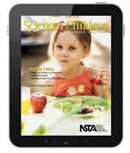Five Ways to Read Science & Children in 15 Minutes
By Carole Hayward
Posted on 2014-06-19


 Science and Children editor Linda Froschauer recently wrote about how elementary school teachers must “intertwine science disciplines and provide many types of disciplinary core ideas within a single topic of study.” Each issue of Science and Children aims to provide timesaving resources that alleviate stress, connect to national standards, and enhance overall student learning. Here are five accessible ways to glean the most important information from your journal subscription in just 15 minutes.
Science and Children editor Linda Froschauer recently wrote about how elementary school teachers must “intertwine science disciplines and provide many types of disciplinary core ideas within a single topic of study.” Each issue of Science and Children aims to provide timesaving resources that alleviate stress, connect to national standards, and enhance overall student learning. Here are five accessible ways to glean the most important information from your journal subscription in just 15 minutes.
- Go digital.
Get your digital edition so you flip through the issue from anywhere: the car wash line, the salon, or even in front of a campfire. (You never know when science inspiration will strike!) But you can also stay in touch with the journal on social media by following Facebook and through the NSTA Twitter feed. Get the latest updates to share with other educators and save for later.
- Boost basic knowledge with Science 101.
Elementary educators are expected to have foundational knowledge in many subjects, but all teachers need a refresher from time to time. Use this column to boost your science knowledge on topics as diverse as friction, sound, and chemistry from Bill Robertson, the author of NSTA Press® best-selling series Stop Faking It! Finally Understanding Science So You Can Teach It.
- Peek into a primary classroom with The Early Years column.
In addition to regular features geared for educators working with students in the PreK to 2 grades, the journal dedicates a column to different aspects of early education. Tackle the challenges of this grade band and get accessible expert advice. If you have more time, explore more on The Early Years blog!
- Inform your budget while connecting to national standards.
Before you spend your money on science-related books, DVDs, and other materials, vet your selections with Science and Children’s columns on best bets for student learning, including resources aligned with Next Generation Science Standards (NGSS) and Common Core standards:
- Teaching with Trade Books
Each month, this column selects specific children’s literature based on the journal’s theme while also presenting engaging activities tailored to K-2 grade levels and the 3-5 grade levels. Use this section to find resources and develop curriculum aligned to Common Core standards and NGSS.
- Early Childhood Resource Review
Appearing three times a year, this column provides an enriched evaluation of new resources for PreK and primary classrooms. Make sure not to miss these well-researched reviews of resources in the elementary science educator field.
- NSTA Recommends
Each month include a fresh crop of recommendations on a wide-range of materials, but the online database has more than 4,000 reviews.
- Dive into teacher-to-teacher classroom stories—and submit one of your own.
Every issue of Science and Children features real-life glimpses of classrooms from around the country. Interested in successful science lessons written by science educators? Enjoy proven classroom experiences through the eyes of educational professionals who create an overview of a specific science investigation from introduction to engagement through assessment.
Take it one step further by submitting your own article. Science and Children is always looking for papers from members. Do you have a success story to share or a science investigation you think science teachers across that nation should know about? Read the guidelines and write for Science and Children!
More time?
Each issue of Science and Children provides resources tailored for NGSS and Common Core standards. Exploring the science of sound, Earth and space sciences, and science literacy are just a few of the topics. Before you start planning, search the archives for topics tailored to your field of study or a particular standard.
Learn more about Science and Children on the NSTA website.
Not a member of NSTA? Learn more about how to join.
Laura Berry of Cogberry Creative is our guest blogger for this series. Laura is a communications professional for the education community.
Disclaimer: The views expressed in this blog post are those of the author(s) and do not necessarily reflect the official position of the National Science Teaching Association (NSTA).

